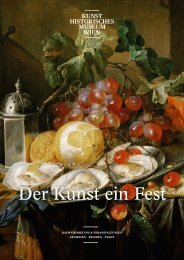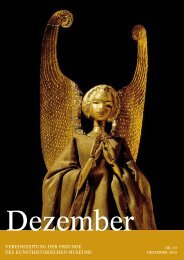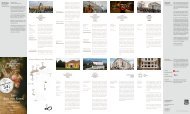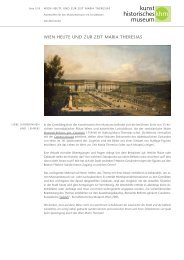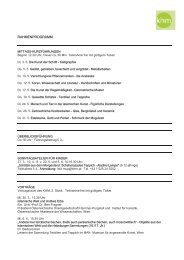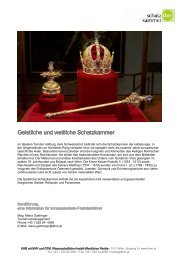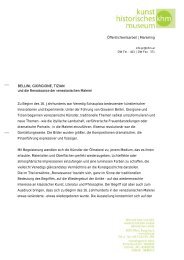Vermeer „Die Malkunst“ - Kunsthistorisches Museum Wien
Vermeer „Die Malkunst“ - Kunsthistorisches Museum Wien
Vermeer „Die Malkunst“ - Kunsthistorisches Museum Wien
Sie wollen auch ein ePaper? Erhöhen Sie die Reichweite Ihrer Titel.
YUMPU macht aus Druck-PDFs automatisch weboptimierte ePaper, die Google liebt.
Bild oder einzelnen Motiven der Komposition auseinander. Die von uns getroffene Auswahl an Werken moderner<br />
und zeitgenössischer Kunst (u. a. Maria Lassnig, Salvador Dalí, Saskia de Boer, George Deem, Gerhard Gutruf<br />
und Peter Greenaway) regt neue, aufschlussreiche Betrachtungsweisen des Originals an und verdeutlicht die weit<br />
reichende Bedeutung von <strong>Vermeer</strong>s Malkunst und ihre Nachwirkung auf die Moderne.<br />
Die zeitlose Aktualität von <strong>Vermeer</strong>s „<strong>Malkunst“</strong> wird schließlich durch ein Kunst- und Modeprojekt illustriert. Vier<br />
Künstler bekamen im Vorfeld zur Ausstellung die Vorgabe, ausgehend von der Kleidung des Malers im Bild eine<br />
Variante des Schlitzwamses zu kreieren. Dabei entstanden Arbeiten, die als feierliches Entree und zugleich<br />
Abschluss der Ausstellung inszeniert werden.<br />
Für den Katalog wurden Spezialisten der unterschiedlichsten Disziplinen eingeladen, das Bild in seinen zahlreichen<br />
Facetten zu beleuchten.<br />
<strong>Vermeer</strong> “The Art of Painting“<br />
Analysis of a Masterpiece<br />
Following its rediscovery by Thoré-Bürger in the 1860’s, the steadily increasing fame of <strong>Vermeer</strong>’s “The Art of<br />
Painting” reached a first crescendo with the travelling exhibition of Austrian treasures organised after the end of<br />
WWII that toured Europe and the United States between 1946 and 1954. Up to 24.142 visitors a day came to see<br />
the painting during the tour’s nine American stops. Ending in 1954, the exhibition was shown in twenty-one cities.<br />
During the painting’s 1950 visit to New York its fragile condition first became apparent; this condition worsened,<br />
making it impossible to loan “The Art of Painting” for the important <strong>Vermeer</strong> exhibition shown in The Hague and<br />
Washington D.C. in 1995/6. Instead it was decided to restore the painting in the conservation workshop of the<br />
<strong>Kunsthistorisches</strong> <strong>Museum</strong>; this delicate task was undertaken between 1995 and 1998 by Prof. Hubert Dietrich,<br />
supported by the chemist, Dr. Werner Jütte.<br />
Although „The Art of Painting“ has established itself as one of the most celebrated works of European art -<br />
attracting countless visitors from around the globe to the <strong>Kunsthistorisches</strong> <strong>Museum</strong> - it was loaned to eight<br />
exhibitions (held in Washington, Moscow, New York, London, Madrid, Tokyo, Kobe and The Hague) in little over<br />
five years since the completion of its restoration in the late 1990’s.<br />
A year-and-a-half ago the suggestion was made to send “The Art of Painting” again to Japan; this led to a debate<br />
that increasingly centred on the painting’s condition. A new analysis of “The Art of Painting” – resulting in a precise<br />
survey of its appearance and a better understanding of its condition – was both a necessity and an opportunity to<br />
write a long-overdue study of <strong>Vermeer</strong>’s technique and handling in this seminal painting.<br />
Renowned colleagues and scholars from all over the world were invited to a colloquium held in Vienna in June<br />
2009. The analysis of the aging processes in “The Art of Painting” was undertaken by Prof. Dr. Jaap Boon of Jaap<br />
Enterprise, Amsterdam, who has worked in this field for many years. The art-historical analysis was under the<br />
auspices of Dr. Arthur Wheelock from the National Gallery of Art in Washington D.C.; he also knows the painting<br />
well, having been involved in the analysis of the painting undertaken before the commencement of the conservation<br />
work executed in connection with preparations for the 1995/6 <strong>Vermeer</strong> exhibition.<br />
For the first time the results of research carried out on the painting culminate in an exhibition in the<br />
<strong>Kunsthistorisches</strong> <strong>Museum</strong> dedicated solely to <strong>Vermeer</strong>’s foremost work, the first-ever exhibition focussed<br />
exclusively on his show-piece. By concentrating on <strong>Vermeer</strong>’s “The Art of Painting” we hope to come as close as<br />
possible to the original intentions of artist and painting: a show-piece in <strong>Vermeer</strong>’s studio, this masterpiece was<br />
meant to be closely studied and admired by potential buyers and connoisseurs. In „The Art of Painting“ <strong>Vermeer</strong><br />
uses an apparently realistic view into an artist’s studio to transmit an allegorical meaning. In doing so, the master<br />
from Delft breaks with a tradition that dates back to the Renaissance: the tradition of depicting the allegory of<br />
painting as a single figure. Here, however, we see the artist at his easel, about to capture the laurel-wreath worn by<br />
his model dressed up as Clio, the muse of History.<br />
Painted between 1666 and 1668, the work’s iconography and handling have given rise to countless interpretations,<br />
all of which are discussed in the exhibition. Props similar to the objects depicted in the painting offer an interesting<br />
as well as aesthetically pleasing introduction to the painting’s complex iconography; in addition, the juxtaposition<br />
invites a direct comparison between the objects and their rendering in paint.<br />
The show addresses both art-historical and technological questions in order to do justice to the exceptional<br />
importance of “The Art of Painting” in <strong>Vermeer</strong>’s oeuvre. The present analysis is both an impartial appraisal of the<br />
picture and of all available earlier studies, taking both the wealth of art-historical writing on “The Art of Painting” and<br />
4





